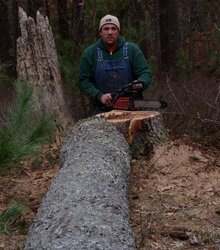I have been "playing" (not exactly the proper term for cutting down trees) with borecutting and felt I was proficient enough at it to drop a big Red Oak I have been aiming to cut down.
I have to say it is a great way to cut down any tree but especially if it is larger than the bar of the saw
Advantage is you dont have to race to set up the hinge.
Start by making the hinge cut and then bore on each side and cut toward the back just above the hinge cut
When you only have a little left to cut you go to the back edge and cut as normal.
I will be borecutting all larger trees from now on
I have to say it is a great way to cut down any tree but especially if it is larger than the bar of the saw
Advantage is you dont have to race to set up the hinge.
Start by making the hinge cut and then bore on each side and cut toward the back just above the hinge cut
When you only have a little left to cut you go to the back edge and cut as normal.
I will be borecutting all larger trees from now on



 ) was falling a large hemlock and when that tree went over it created suction behind as do most larger trees and it actually broke a dead snag tree behind him and he never saw it. He said all he could remember was it felt like someone was forcing him to the ground then lights out. He lived to tell the tale and still works in the woods. Most fatalities and serious injuries occur within 12 feet of the tree you are cutting that is why you should retreat along your escape path a minimum of 15' or more depending on conditions. It is dangerous work but I wouldn't trade it for anything.
) was falling a large hemlock and when that tree went over it created suction behind as do most larger trees and it actually broke a dead snag tree behind him and he never saw it. He said all he could remember was it felt like someone was forcing him to the ground then lights out. He lived to tell the tale and still works in the woods. Most fatalities and serious injuries occur within 12 feet of the tree you are cutting that is why you should retreat along your escape path a minimum of 15' or more depending on conditions. It is dangerous work but I wouldn't trade it for anything.